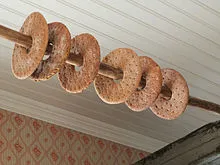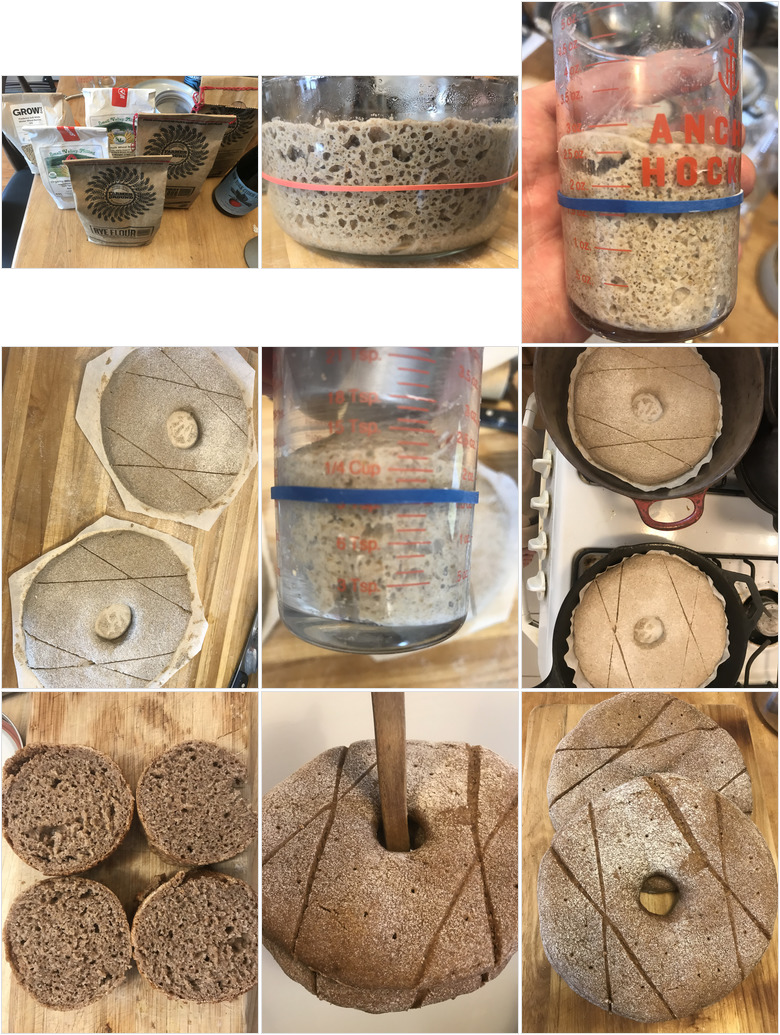I stopped by the Grow NY grain stand at the local farmers market and picked up the lone bag of Frederick soft white wheat berries they had and a few bags of stone-ground flour from Farmer Ground and Small Valley Farm so I could sample some local wheat varieties and try a few bakes with professionally milled whole grain flour for comparison with Mockmilled flour. Larger bags of wheat berries can be ordered for pick up in advance. I am interested in the Renan flour, but a 50 lb minimum is a bit intimidating. If someone in the NYC area is interested in splitting an order please let me know.
In addition to the wheat flour, I picked up one bag of whole rye from Farmer Ground. I have been wanting to try the recipe for the Finnish (ruis)reikaleipa from Daniel Leader's Living Bread, so I queued it up. (Leader refers to it as reikaleipa, although Wikipedia clarifies the rye version is technically ruisreikaleipa.) It is a thin circular UFO-like rye with a hole in the middle, which was traditionally used for storage and aging on poles just below the kitchen ceiling.
From Wikipedia:

This is lower hydration than the whole rye Volkornbrot I've been learning to bake and has a pleasantly chewy texture. It would be a great bread for a camping trip! It employs a single rye sour build prior to the final mix, but I was quite surprised by the depth of flavor from such a simple formula, and am not now unsure why I don't bake rye more often. Leader recommends consuming within 4 days, although various articles I have seen suggest these were often baked in large quantities and consumed well beyond that. Taking a hint from the small Finnish cafe where these were photographed, we baked the holes and post stenciling dough remnants as biscuits and ate them as egg sandwiches for brunch to get a preview of the flavor while the larger loaves cooled. The recipe suggests baking a 12 inch round with steam, although our gas oven is unforgiving to uncovered bakes, so I opted for two 8 inch discs that would allow for covered bakes in a round DO and lodge pan at 400 F for 40 minutes. The photos below indicate a doubling in the initial rye sour after approximately 12 hours, followed by a roughly 30% rise of the final mix at 1.5 hours and an additional 25% post-shape rise after 45 minutes with a corresponding reset of the aliquot jar.
I noticed the crust puffing up in a few places after I uncovered it, so I used a chopstick to dock it while it was in the oven. I will probably do that ahead of time for the next bake.
- headupinclouds's Blog
- Log in or register to post comments
One thing to try: if you press the cut out middle parts really thin, they puff up in the oven like pita bread.
Thanks for the tip. I can try that next time. I haven't made pita yet, but have made a fair number of chapatis. Puff-up breads are fun to make, and perhaps fill the void from all of the oven spring I miss in sourdough bread due to use of a DO. I think the whole ruisreikaleipa could be made as a rye pita with the same press down step.
Interesting bread, I’d love to see the formula if you wouldn’t mind posting it. I still haven’t baked any 100% rye breads yet and probably need to do so.
Benny
Summary:
The flavor-to-effort ratio is pretty high in this one, and I'm surprised how light it feels for whole rye flour. Cleaning up is probably the hardest part with these viscous bakes! I think the form factor is fairly forgiving and it is probably a good intro-to-rye loaf. The crust-to-crumb ratio gives a nice light and chewy texture. I might increase the final hydration for this flour in the next bake a little, but the formula worked quite well for me.
Thanks for sharing this, it’s such an interesting bread. I agree with Mini, the lines you’ve added are a very modern touch.
Full disclosure ... I can't take credit for the X design. The recipe calls for them :)
I gotta make me some. Lines make a modern touch.
Not that I have mice or even bigger mice....but...
I often try to imagine the frustration of pesky critters trying to reach this bread suspended "in the clouds." Critters that helplessly spin out whipping their tails about only to drop dizzy to the floor. A good design and clever storage method. (Do they have something like this in an japanese endurance game show?). Would a small version be fun for small pets? ...perhaps the middles? Birds? Hamsters? Or mice? Ferrets?
Now I have yet another bread baking accessory to cram into our apartment ... a ruisreikaleipa pole! I can't find them online anywhere, probably due to pandemic-related supply shortages. I like where this is headed. This shape has nearly limitless potential. It could also make a handy weapon that can hide in plain sight. I'm thinking of a Finnish baking villain (Oddjob's razor rimmed hat) in a new James Bond film, whos bakery is really a front for Spectre. After 6 months of aging, these might actually hold an edge.
On a different note, due to a modern-day ordering mishap, we have ended up with a ridiculous amount of chia seeds. I think your chia loaf is somewhere on my horizon.
I haven't done it yet but chia toasted before tossing into the dough might be a good way to up the flavour. I find Chia imparts neutrality to other grains. (Ah! Chia might be a good mix with quinoa. The more I think about it the more sense it makes. They both grow in similar areas and chances are good ancient and modern foodies combined these two ...and other South American flavours.)
I've seen the recipe for these but haven't ever baked them myself. Looks like you did very well with them.
Paul
Thanks Paul. It lifted up in a few spots, but I don't think anyone will notice. I read your review of Living Bread a while back. There are a few interesting ones in this book. The laminated honey rye on the following page is very intriguing. Florian Domberger's crispy dunked seele loaf would be another fun one.
yup, gotta make me some. Where is that pool que? -¿------¿-